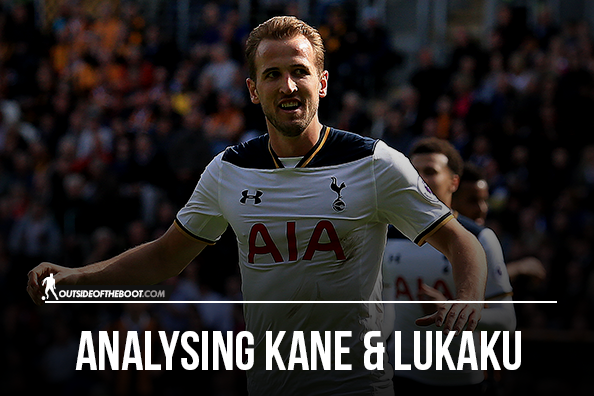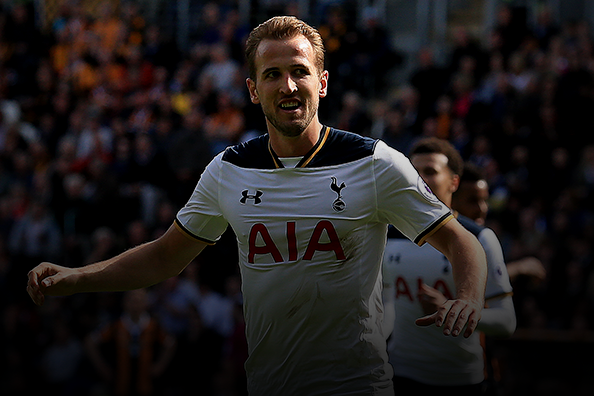Jake Askham writes a detailed analysis comparing the 2 best strikers of the Premier league: Harry Kane, and Romelu Lukaku.
After 7 goals in the last 2 games of the season, I thought it’d be a good idea to look at the numbers behind Harry Kane’s performances this season. What does he do differently and what makes him one of the most prolific strikers in the world? To make it interesting, I’ve compared data and video footage of himself and Romelu Lukaku to get an overview of their performances this season and how they’re similar and different. To make it easy to read, we’ll split it down into different categories:
- Shot Location and Goal Types
- Movement
- Other Factors
- Goal Importance

Shot Location
The location of a shot is one of the key variables in whether it will end up being a goal, as is the angle of the shot and the number of players between the ball and the goal.
Harry Kane
So let’s take a quick look at where he’s been taking his shots from and where he scores his goals from.

The image above shows the location of all his shots from the 2017/2018 seasons. As you’d expect, most of his shots are in and around the box. There’s a denser area around the inside right area of the box (the red square). Which again is to be expected as he is right footed and would be more likely to drift to the right to get the ball onto his favoured foot.

When we then look at the location of his goals we get a similar picture. There is a much denser space in the inside right location where he has scored a high number of his goals. If we split the pitch in half horizontally, we can see that the majority of his goals do come from the right side of the pitch.

Of the 29 goals he’s scored this season, 20 of those have come with his right foot, 7 with his left foot and 2 headers. He’s taken 71 shots with his right foot, 26 with his left foot and 13 with his head. This gives him a 28% shot conversion rate with his right foot, 27% conversion rate with his left foot and a 15% conversion rate with his head.

The above image shows the location the ball entered the net when he scored his goas. As you can see, the majority of his goals are scored with the ball entering the lower left corner. That would suggest he’s confident hitting the ball across the goalkeeper with power. Also, notice how the majority of the goals are scored when the ball enters the goal in a low position rather than the top of the net.
Romelu Lukaku
First is the image of the shot location of all Lukaku’s shots from the 2016/2017 season.

In the above image, we can see a large cluster of shots in the centre of the goal and around the penalty spot. Considering Lukaku is a left footed player, it’s interesting to see a lower number of shots in the left half of the box when compared to the right hand side. This might be due to the fact he’s more comfortable shoot with the instep and finding the far corner with a curling shot from the right hand side than shooting from the left and relying on a powerful shot to beat the goalkeeper.

The above image now shows the location of his goals. When compared to the goal location of Harry Kane, you’ll see these are much more compact and only 1 goal has been scored outside of the box compared to Kane who scored 4 goals from outside of the box.

As expected, the majority of Lukaku’s goals come from his left foot. He also scores a higher number of headed goals than Harry Kane. Kane attempted 13 headers in the 206/2017 season and scored 2 whilst Romelu Lukaku attempted 18 and scored 6 of them. From this data we can’t tell if Lukaku is better aerial threat as we don’t have the shot location of the headers.

When we look at the location of Lukaku’s goals, we can see a cluster of goals highlighted in the red rectangle. Kane seemed to score most of his goals with shots towards the bottom of the net with very little height, whereas Lukaku seems to opt to get height on his shots.
Movement
Harry Kane
Harry Kane’s movement is a key part of his success. His ability to create small pockets of space to shoot is crucial. The video below shows 3 goals from this season in which he makes space for his goals.
From the video you can see his ability to move into space at the right time is crucial allows him to get his shots off. Rather than constantly moving and hoping he gets into the right position, his ability to be patient and move quickly when the situation arises is key.
Romelu Lukaku
Lukaku’s movement is extremely impressive and his ability find half a yard of space is crucial to his success. He often moves to the right side of the pitch to receive the ball and aims to get in the space between the LB and the CB, leaving the two centre-backs marking no one and creating an overload at the back post.
The video above shows just how good Lukaku is at moving into pockets of space and he isolates defenders.
Other Factors
Romelu Lukaku is another striker who was competing for the top goal scorer in the 2016/2017 season, but he’s been playing in a considerably worse team. A key factor of Harry Kane’s success has been the team he’s been playing in. Tottenham have been fantastic throughout the season and their performance saw them score the most goals and concede the fewest, finishing with a goal difference of 60 compared to Chelsea’s 52.
Two of the best attacking midfielders in the league this season have been Christian Eriksen and Dele Alli. Between them, they have contributed an incredible 22 assists. (15 for Eriksen and 7 for Alli). Having two fantastic creative footballers behind him will have certainly helped him. Let’s compare that to Lukaku, who has had to score the majority of the goals himself. The two highest assist numbers for Everton are Ross Barkley and Kevin Mirallas who only achieved, 9 assists between them (5 for Barkley and 4 for Mirallas).
Goal Importance
When comparing Harry Kane and Romelu Lukaku, there’s little to separate the two players. Harry Kane’s output per 90 minutes is higher than Lukaku’s, but that doesn’t necessarily mean he’s a better player or more important to his team. Let’s have a look at the match situation when both players scored goals for their respective clubs.
| Goal difference | Lukaku | Kane |
| -2 + | 3 | 0 |
| -1 | 1 | 2 |
| 0 | 7 | 10 |
| 1 | 7 | 7 |
| 2 + | 6 | 10 |
| Total | 24 | 29 |
When looking at the match situation when both players scored their goals we can see that a high percentage (34%) of Harry Kane’s goal came when his team was winning by 2 or more goals. Kane didn’t score a goal when his side were 2 or more goals behind in a game (because it didn’t happen often) whereas Lukaku scored 13% of his goals when his side were 2 or more goals behind. In the games where Lukaku score goals whilst his team were 2 or more goals behind, they collected 0 points (Watford Away, Arsenal Away and Tottenham Away), so those goals didn’t help his side gain more points.
Overall Comparison

Overall, there’s little to separate Harry Kane and Romelu Lukaku but this season, Kane has been the better player. With Lukaku’s future at Everton very uncertain, it would be extremely interesting to see how the Belgian striker would fare if he was playing in a top quality team. Would he thrive with the additional quality around him and take the role as the leading goal scorer or would he be utilised as a strong powerful centre-forward whose primary job is to allow the creative players around him to exploit the space he creates? Either way, Lukaku is an extremely talented footballer and it’ll be fantastic to watch his development.
Harry Kane on the other hand is knocking on the door of world class. His rise over the last 3 seasons has been remarkable and he is undoubtedly the best English striker at the moment. If he produces the goods next season and contributes to another successful season for Tottenham in the Premier League and improves his form in the Champions League then he’ll be truly in the world class bracket.
Data taken from:
- Analysis: Harry Kane v Romelu Lukaku - June 8, 2017
- Tactical Principles: Half Spaces - September 7, 2016
- Tactical Principles: The Low Block - July 21, 2016
























































